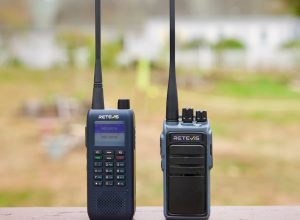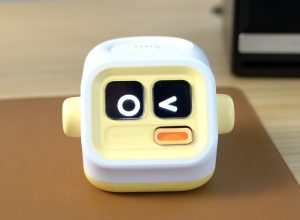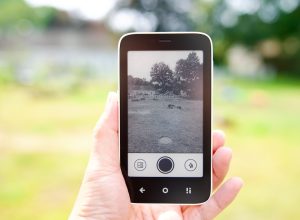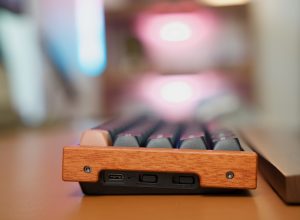Did you know that IBM released the first smartphone in 1994?
You likely own a smartphone, and there’s a good chance you’re reading this article on your smartphone. However, you probably don’t know the rich history of the smartphone, from its inception 30 years ago to its evolution.
There’s no need to worry because you’ve come to the right place to learn more about the history of this ubiquitous mobile device. This article will briefly explain the evolution of smartphone models, from the first smartphone to modern flagship devices.
Simon Personal Communicator: The First Smartphone (1994)
As mentioned, IBM released the first smartphone, the Simon Personal Communicator (also known as IBM Simon), in 1994.
IBM Simon was innovative and laid the foundations for mobile applications. The device was both a traditional mobile phone and a digital personal assistant.
Specifications
- Liquid crystal display (LCD)
- Touch-screen user interface
- PC card support (The IBM Simon could interface with laptops)
- Vadem VG230 system-on-a-chip (SOC)
- Datalight ROM-DOS file system, Stacker file compression
- Sony and Hitachi Random Access Memory (RAM) Chips
- Intel and Hitachi flash memory chips
- Cirrus Logic modem chips
- Nickel-cadmium battery (Each unit included a charging base station.)
Unique features
The IBM Simon had many features that were unique for the time, including:
- An electronic calendar that allows you to manage your schedule
- Address book
- Sending and receiving emails and faxes
- Calculator
Ericsson GS88: The Canceled Smartphone (1997)
Although history credits the IBM Simon as the first smartphone, people didn’t use the term “smartphone” until 1997.
Swedish telecommunications giant Ericsson coined the term “smart-phone” in 1997 when describing the GS88 (also known as Penelope), its new mobile device.
Although Ericsson canceled the GS88 and never made it publicly available, it deserves to be in the smartphone discussion for its innovation.
Specifications
- GEOS 16-bit operating system (OS)
- Integrated modem
- Infrared port
Unique features
The Ericsson GS88 had features the IBM Simon didn’t. Here are some of the Ericson GS88’s unique features.
- QWERTY keyboard and LCD panel
- Memory expansion card
- Post-Office Protocol 3 (POP3) email
- Speakerphone
Benefon Esc!: The First Phone With a GPS (1999)
In 1999, Benefon (now Twig Com) launched the Benefon Esc!, the first phone with a Global Positioning System (GPS).
Unfortunately, the phone was only popular in Europe, and Benefon discontinued it in the early 2000s.
Specifications
- 100 x 160-pixel monochrome graphic display
- 700 mAh lithium-ion battery
- Infrared port
Unique features
Although the Benefon Esc! was not a well-known phone, it still paved the way for companies to integrate GPS into phones.
Besides the GPS, the Benefon Esc! also had built-in maps and a dynamic font system that allowed users to choose their preferred font size.
FOMA N2001: The First 3G Phone (2001)
Japanese telecommunications company Nippon Telegraph and Telephone (NTT) Docomo launched the first 3G network in Japan in 1998. However, the company didn’t make 3G commercially available until October 2021 with the release of the Freedom of Mobile Multimedia Access (FOMA) 3G service.
NTT also released the FOMA N2001 smartphone in 2001 to coincide with the release of the 3G service.
Specifications
- Symbian OS-based Mobile-Oriented Applications Platform (MOAP)
- Bright, 4096-color, 2.2-inch Organic EL (OLED) screen
- 60 to 90 minutes of active battery life (can last approximately 55 hours on standby)
- Infrared communication
Unique features
The FOMA N2001 had many features that were revolutionary for its time, with the most significant feature being wireless internet browsing.
With the FOMA N2001’s 3G network, users could surf the web at approximately 384 kilobits per second. Users could also download Java programs in seconds.
Although other phones before the FOMA N2001 allowed users to send and receive emails, they only allowed short messages. With the FOMA N2001, users could send and receive emails up to 5,000 characters or around 700 words.
Apple iPhone: The First iPhone (2007)
Apple launched its first smartphone and first iPhone model in the US on June 29, 2007.
Apple sold approximately 6.1 million units of its first iPhone, popularizing the use of the modern smartphone and forever changing the world of mobile communications.
However, as popular as the iPhone was, it was not the “first” in many aspects.
For example, it’s a common misconception that the iPhone was the first touchscreen phone and that the touchscreen was Steve Jobs’ idea. This isn’t true.
The IBM Simon was the first touchscreen mobile phone—the iPhone just popularized this feature.
To be fair, the 2007 iPhone was the first phone to have multi-touch technology, allowing the screen to recognize more than one finger or contact point.
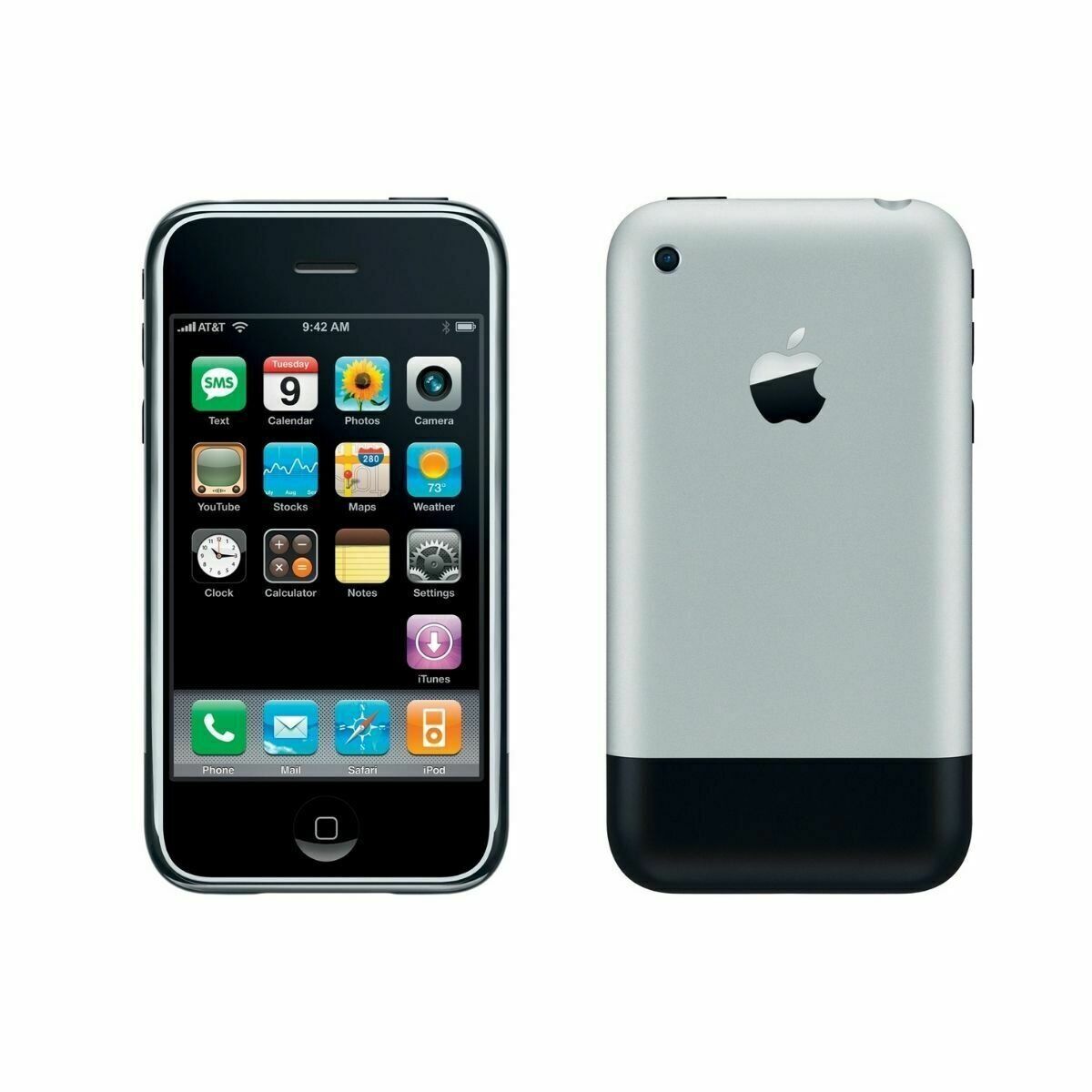
Specifications
- iPhone OS (1.0 to 3.1.3)
- Samsung 32-bit RISC ARM CPU
- 128 embedded DRAM (eDRAM)
- Flash memory (available in 4, 8, and 16 GB models)
- 3.7 V 1400 mAh lithium-ion battery
- 480×320 pixel, 18-bit (262,122) color LCD screen
- Quad-band GSM, GPRS, EDGE, Wi-Fi connectivity
- Bluetooth 2.0
- 2-megapixel rear camera
Unique features
The first-generation iPhone popularized GPS and other location services on mobile phones.
This smartphone had Google Maps, which had an address autocomplete API. APIs provide more positive user experiences and more accurate location search results. Users didn’t need to type an entire address because their device would do it via predictive text input.
Besides location services, the iPhone had other innovative features for its time. It could connect to Wi-Fi and play audio and video files. It was also the first iPhone with the Safari browser, Apple’s proprietary internet browser that the company claims is the world’s fastest browser.
HTC Dream: The First Android Phone (2008)
Google acquired startup company Android in 2005 for an undisclosed amount (although the estimate is around $50 million).
Then, in October 2008, HTC released the Dream (also known as the T-Mobile G1 in the US), the first Android OS smartphone.
Specifications
- Android 1.0 to 1.6 (Donut) OS
- 3.2-inch, 320 x 480-pixel, 180 ppi density, thin-film-transistor liquid-crystal display (TFT LCD)
- 528 MHz ARM 11 CPU
- 192MB or 256MB RAM
- 3.15-megapixel rear camera with autofocus
Unique features
This smartphone’s most significant and unique feature is naturally its Android OS.
The HTC Dream was the first smartphone that could integrate with Google apps and services, including Gmail, Google Maps, Google Search, Google Calendar, Google Contacts, and YouTube.
Android OS is also open source, meaning knowledgeable users can modify its source code. Thus, the HTC Dream became popular with modders who customized and enhanced the device’s OS.
The Evolution of Smartphones: 2008 and Beyond
This article doesn’t discuss the entire history of mobile phones because to do that requires a much longer article.
However, learning a little about the revolution of smartphones will help you appreciate how today’s mobile devices make your life so much easier.
In the early days of mobile phones, a device that could send and receive emails was already life-changing.
Fast forward to now, and you can shop for groceries online on your smartphone, get the exact location of any store, capture and edit high-resolution photos and videos, and even play graphically demanding mobile games.
Today’s smartphones have come a long way since their humble beginnings three decades ago.
